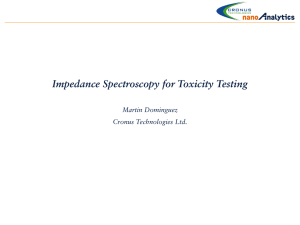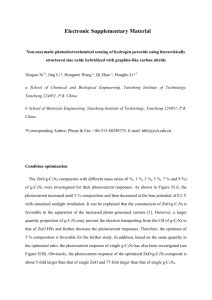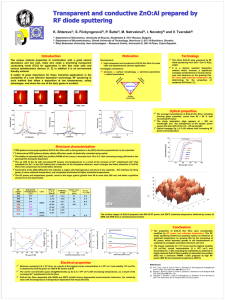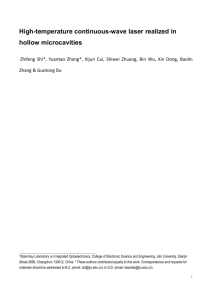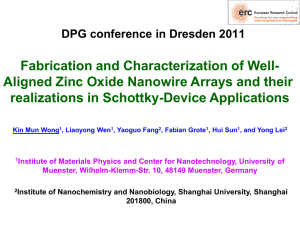supporting_information
advertisement
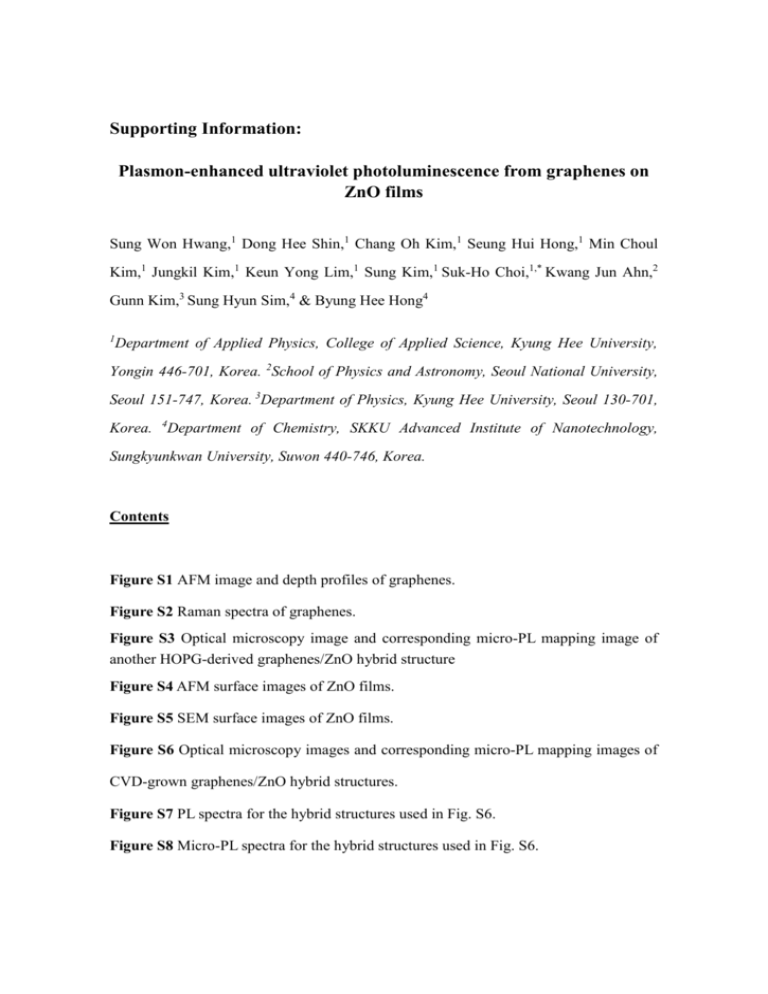
Supporting Information: Plasmon-enhanced ultraviolet photoluminescence from graphenes on ZnO films Sung Won Hwang,1 Dong Hee Shin,1 Chang Oh Kim,1 Seung Hui Hong,1 Min Choul Kim,1 Jungkil Kim,1 Keun Yong Lim,1 Sung Kim,1 Suk-Ho Choi,1,* Kwang Jun Ahn,2 Gunn Kim,3 Sung Hyun Sim,4 & Byung Hee Hong4 1 Department of Applied Physics, College of Applied Science, Kyung Hee University, Yongin 446-701, Korea. 2School of Physics and Astronomy, Seoul National University, Seoul 151-747, Korea. 3Department of Physics, Kyung Hee University, Seoul 130-701, Korea. 4Department of Chemistry, SKKU Advanced Institute of Nanotechnology, Sungkyunkwan University, Suwon 440-746, Korea. Contents Figure S1 AFM image and depth profiles of graphenes. Figure S2 Raman spectra of graphenes. Figure S3 Optical microscopy image and corresponding micro-PL mapping image of another HOPG-derived graphenes/ZnO hybrid structure Figure S4 AFM surface images of ZnO films. Figure S5 SEM surface images of ZnO films. Figure S6 Optical microscopy images and corresponding micro-PL mapping images of CVD-grown graphenes/ZnO hybrid structures. Figure S7 PL spectra for the hybrid structures used in Fig. S6. Figure S8 Micro-PL spectra for the hybrid structures used in Fig. S6. 1. AFM image and depth profiles of graphenes The AFM height profiles of typical HOPG-derived graphenes on a ZnO film identified steps between graphenes and between graphene and the ZnO film. The heights for each step were about 0.35 and 0.8 nm, respectively. It has been reported that the AFM step height of a SG on SiO2 varies between 0.5 and 1 nm and the apparent thickness of a SG is 0.35 nm [1-3].This indicates that the graphene flakes on a ZnO film are well characterized also by the AFM height profiles. Figure S1. (a) AFM topographic image of typical graphene flakes on a ZnO film. (b) Depth profile along the red line in Fig. 1(a). (c) Depth profile along the blue line in Fig. 1(a). The ZnO film was annealed at 900 oC. 2. Raman spectra of graphenes We obtained Raman spectra for the graphene layers on ZnO film and compared them with previous ones [3-5]. Two distinctive features in the Raman spectra were the G peak at 1580 cm-1 and the 2D peak at 2700 cm-1. The most prominent difference in the spectra of SG, FGs, and HOPG lay in the 2D peak, but the 2D peaks of FGs with the number of layers n 5 was hardly distinguishable from that of HOPG. The peak position of SG was at 2683 cm-1, exactly same with that reported in Ref. [4]. The shape and the peak position of HOPG coincided with those in Ref. [2-4] as well. The Lorentzian lines to best fit the 2D peaks of the FGs were compared with those in the previous reports [3,4] to distinguish among FGs with different numbers of layers (n = 2, 3, and n 5). Figure S2. Raman spectra of graphenes with n = 1, 2, 3, and n 5 on ZnO films and HOPG. a.u.- arbitrary units. The data were collected using 514.5 nm radiation under ambient conditions. The ZnO films were annealed at 900 oC. 3. Optical microscopy image and corresponding micro-PL mapping image of another HOPG-derived graphenes/ZnO hybrid structure Figure S3. Optical microscopy images showing the graphene regions that are separated from the bare region on the surface of ZnO film for another typical hybrid structure of HOPG-derived graphenes/ZnO films and corresponding micro-PL mapping image. The ZnO films were annealed at 900 oC. 4. AFM and SEM surface images of ZnO films depending annealing temperature Figure S4. AFM surface images of ZnO films for various annealing temperatures. Figure S5. SEM surface images of ZnO films for various annealing temperatures. 5. Optical microscopy images and corresponding micro-PL mapping images of CVD-grown graphenes/ZnO hybrid structures Figure S6. Optical microscopy images showing CVD-grown graphene regions (B) that are separated from the bare region (A) on the surface of ZnO film for hybrid structures with few-layer graphenes with (a) n =12, (b) n =35, and (c) n > 5, and corresponding micro-PL mapping images. 6. PL and micro-PL spectra for the hybrid structures used in Fig. S6 Figure S7. PL spectra for the 3 types of hybrid structures used in Fig. S6. The inset shows the PL intensity as a function of layer number. The PL intensity decreases with the increasing number of graphene layers, indicating that only PL blocking effect by the graphenes exists without the plasmon-mediated effect. Figure S8. Micro-PL spectra for the 3 types of hybrid structures used in Fig. S6. The inset shows the micro-PL intensity as a function of layer number. References [1] K. S. Novoselov, A. K. Geim, S. V. Morozov, D. Jiang, M. I. Katsnelson, I. V. Grigorieva, S. V. Dubonos, A. A. Firsov, Nature 438, 197 (2005). [2] U. Stöberl, U. Wurstbauer, W. Wegscheider, D. Weiss, J. Eroms, Appl. Phys. Lett. 93, 051906 (2008). [3] A. Gupta, G. Chen, P. Joshi, S. Tadigadapa, P. C. Eklund, Nano Lett. 6, 2667 (2006). [4] A. C. Ferrari, J. C. Meyer, V. Scardaci, C. Casiraghi, M. Lazzeri, F. Mauri, S. Piscanec, D. Jiang, K. S. Novoselov, S. Roth, A. K. Geim, Phys. Rev. Lett. 97, 187401 (2006). [5] D. Graf, F. Molitor, K. Ensslin, C. Stampfer, A. Jungen, C. Hierold, L. Wirtz, Nano Lett. 7, 238 (2007).
